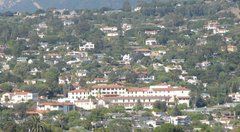
Islam has been described as an urban religion. It grew to dominance of Arabia by controlling two key cities, Mecca and Medina. It went on to establish itself in such capitols as Baghdad, Damascus, Cairo, Istanbul, Cordoba, and Jerusalem.
When Muslim raiders succeeded in establishing bases in Europe they left behind examples of their ideals for town planning. Winding, narrow streets with tall buildings hiding pleasant interior courtyards can be found in major Spanish cities and in some districts of Italian villages.
The goal of Islamic planning was both defensive and decorous. The twisting alleys that often ended in a cul-de-sac or dead end made invasion difficult and costly. Meanwhile the buildings' interior focus served the needs of modesty and separated home life from the business of the city.
Narrow alleys and tall blocks also served the mostly hot and arid climates of Muslim landholdings. This layout minimized solar penetration of the interior of the blocks and buildings while funneling cool evening breezes down the lanes. The minimum width for such streets was set a the practical room necessary to pass two loaded camels side by side.
Some architectural features were also demanded by the combination of Islam and urban life. The screened window boxes and bridges found in cities such as Tunis and Beirut were developed to enable women to pass from building to building of a family compound or to view the bustle of the street with out exposing themselves to the view of non-family males. Today these elements are some of the most intricate, artistic, and endearing of Islamic cities.

1 comment:
This a good example of a Eurocentric and shallow view of Islamic architecture and urban planning; it merely eccos the 18th 19th and early 20th centuries' orientalist views.
Narrow winding streets and courtyards have nothing to do with defence - being good for defence is actually a coincedence! The exact same courtyard houses can be found in the ruins of Babylon, many centuries before Islam!
Islamic effect on Spain is a little more than "raiders", about 800 years of full fledge rule more!!
Moreover, the claim that Islam is an "urban religion" is a very misleading statement - it implies that people in the coutryside and in suburban and rural settings were not affected by Islam!!! It also implies that other relgions did not have capitals at certain periods of time - does Rome ring a bell?
Before writing a comment on Islamic urban planning (with claims presented as facts) how about you try to actually read about the subject a little.
Post a Comment